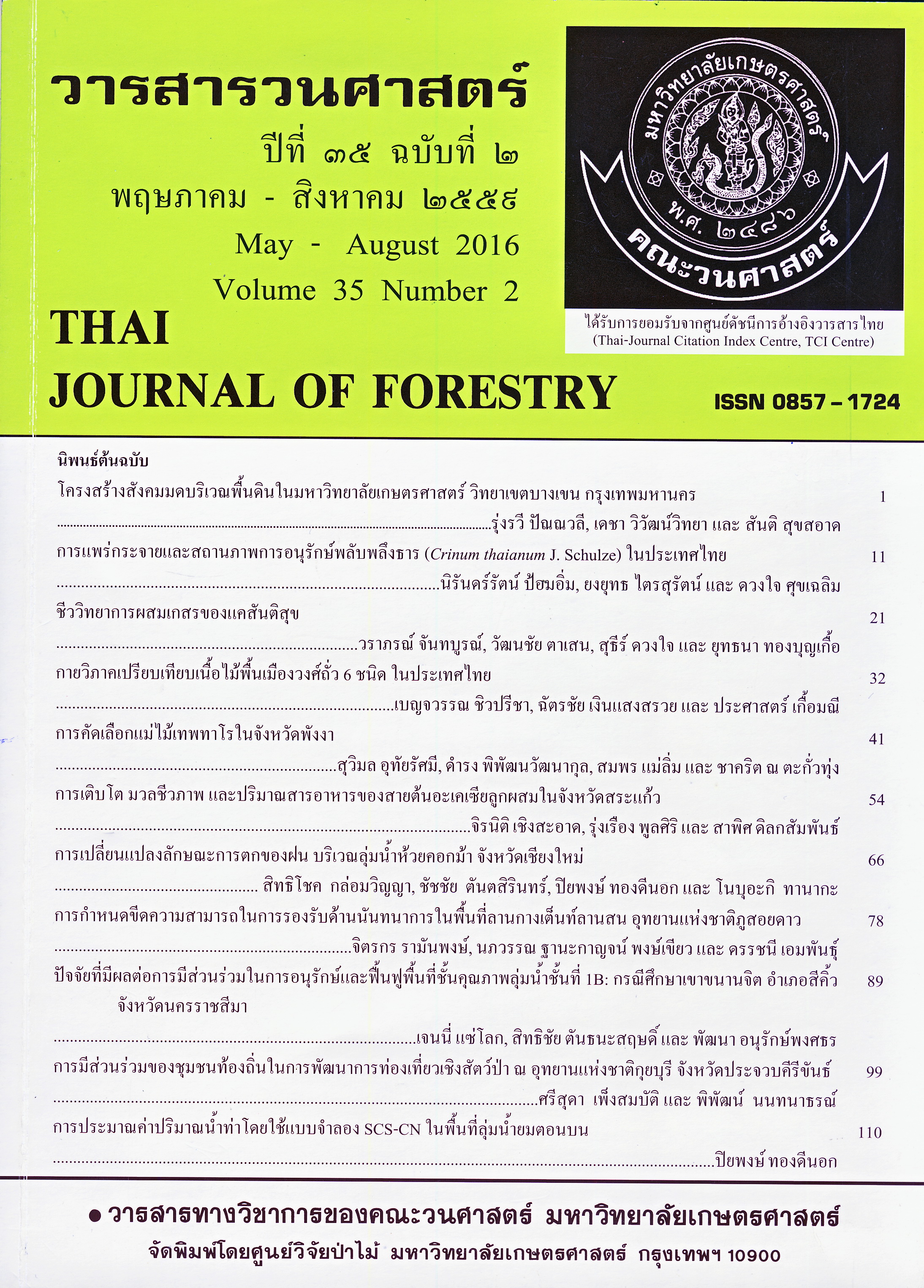การประมาณค่าปริมาณน้ำท่าโดยใช้แบบจำลอง SCS-CN ในพื้นที่ลุ่มน้ำยมตอนบน
Main Article Content
บทคัดย่อ
การศึกษาครั้งนี้เป็นการประยุกต์ใช้ข้อมูลและเทคนิคทางด้านระบบสารสนเทศภูมิศาสตร์ร่วมกับวิธีการของแบบจำลอง SCS-CN เพื่อประเมินปริมาณน้ำท่า รวมทั้งเปรียบเทียบปริมาณน้ำท่าที่ได้จากการคำนวณจากแบบจำลอง SCS-CN กับข้อมูลปริมาณน้ำท่าที่ได้จากการตรวจวัด โดยการรวบรวมข้อมูลลักษณะภูมิประเทศ ข้อมูลชุดดินและการใช้ประโยชน์ที่ดิน จากนั้นทำการวิเคราะห์ข้อมูลลักษณะภูมิศาสตร์กายภาพ และลักษณะทางอุทกวิทยาเพื่อประเมินค่า CN และพิจารณาความสัมพันธ์ของปริมาณน้ำฝนและน้ำท่าซึ่งเป็นค่าดัชนีบ่งชี้สถานภาพทางอุทกวิทยาและศักยภาพการให้น้ำท่าของพื้นที่ลุ่มน้ำยมตอนบน
ผลการศึกษาพบว่า ปริมาณน้ำท่ารายปีเฉลี่ยจากแบบจำลอง SCS-CN มีค่าเท่ากับ 625.71 ล้านลูกบาศก์เมตร โดยปริมาณน้ำท่าจากการตรวจวัดจริงมีค่าเท่ากับ 828.23 ล้านลูกบาศก์เมตร ความสัมพันธ์ระหว่างปริมาณน้ำฝนกับปริมาณน้ำท่า พบว่าอยู่ในระดับปานกลาง (r2 = 0.6) ปริมาณน้ำท่าช่วงฤดูน้ำหลากจากแบบจำลองมีค่าเท่ากับ 633.06 ล้านลูกบาศก์เมตร โดยมีค่าที่ได้จากการตรวจวัดเท่ากับ 916.22 ล้านลูกบาศก์เมตร ส่วนช่วงฤดูน้ำแล้ง พบว่าปริมาณน้ำท่าจากแบบจำลองมีค่าเท่ากับ 7.35 ล้านลูกบาศก์เมตร โดยค่าตรวจตรวจวัดได้เท่ากับ 87.99 ล้านลูกบาศก์เมตร ความสัมพันธ์ระหว่างปริมาณน้ำฝนและปริมาณน้ำท่า พบว่ามีค่าสูงในช่วงน้ำหลาก (r2 = 0.9) และมีค่าปานกลางในช่วงแล้งฝน (r2 = 0.55) การศึกษาลักษณะทางอุทกวิทยา พบว่าร้อยละปริมาณน้ำท่าต่อปริมาณน้ำฝนมีค่าเท่ากับ 67.9 ร้อยละของปริมาณน้ำท่าช่วงน้ำหลากต่อช่วงน้ำแล้งเท่ากับ 99:1 ส่วนช่วงเวลาการไหลในช่วงน้ำหลากต่อช่วงน้ำแล้งเท่ากับ 7:5 เดือน การเปลี่ยนแปลงการใช้ประโยชน์ที่ดินที่ควรเป็นตามนโยบายการจัดชั้นคุณภาพลุ่มน้ำพบว่าปริมาณน้ำท่าที่ได้จากการคำนวณของแบบจำลองมีค่า 695.89 ล้านลบ.ม. ค่า CN เท่ากับ 77 การเปลี่ยนแปลงการใช้ประโยชน์ที่ดินให้เหมาะสมตามระดับความลาดชัน พบว่าปริมาณน้ำท่าที่ได้จากการคำนวณของแบบจำลองมีค่า 599.13 ล้านลบ.ม.
Downloads
Article Details
ข้าพเจ้าและผู้เขียนร่วม (ถ้ามี) ขอรับรองว่า ต้นฉบับที่เสนอมานี้ยังไม่เคยได้รับการตีพิมพ์และไม่ได้อยู่ในระหว่างกระบวนการพิจารณาตีพิมพ์ลงในวารสารหรือสิ่งตีพิมพ์อื่นใด ข้าพเจ้าและผู้เขียนร่วม (ถ้ามี) ยอมรับหลักเกณฑ์และเงื่อนไขการพิจารณาต้นฉบับ ทั้งยินยอมให้กองบรรณาธิการมีสิทธิ์พิจารณาและตรวจแก้ต้นฉบับได้ตามที่เห็นสมควร พร้อมนี้ขอมอบลิขสิทธิ์ผลงานที่ได้รับการตีพิมพ์ให้แก่วารสารวนศาสตร์ คณะวนศาสตร์ มหาวิทยาลัยเกษตรศาสตร์ กรณีมีการฟ้องร้องเรื่องการละเมิดลิขสิทธิ์เกี่ยวกับภาพ กราฟ ข้อความส่วนใดส่วนหนึ่ง หรือ ข้อคิดเห็นที่ปรากฏในผลงาน ให้เป็นความรับผิดชอบของข้าพเจ้าและผู้เขียนร่วม (ถ้ามี) แต่เพียงฝ่ายเดียว และหากข้าพเจ้าและผู้เขียนร่วม (ถ้ามี) ประสงค์ถอนบทความในระหว่างกระบวนการพิจารณาของทางวารสาร ข้าพเจ้าและผู้เขียนร่วม (ถ้ามี) ยินดีรับผิดชอบค่าใช้จ่ายทั้งหมดที่เกิดขึ้นในกระบวนการพิจารณาบทความนั้น”
เอกสารอ้างอิง
Mishra, S.K., R.P., Pandey, M.K., Jain and V.P., Singh. 2008. A rain duration and modified AMC-dependent SCS-CN procedure for long duration rainfall-runoff events. WATER RESOUR MANAG. 22 (7): 861-876.
Ramakrishnan, D., A., Bandyopadhyay and K.N., Kusuma. 2009. SCS-CN and GIS-based approach for identifying potential water harvesting sites in the Kali Watershed, Mahi River Basin, India. J. Earth. Syst. Sci. 118 (4): 355-368.
Saard, P. 2008. Determining od Soil Water Characteriatic Curve Equation for Estimating Soil Moisture Change at Mae-Sa Watershed, Chiang Mai Province. Thai J. For. 27 (1): 28-42.
Taesombat, V. 1990. Principle of Hydrology. Physic center publication. Bangkok.
Thangtham, N. 1996. Watershed Soil hydrology. Faculty of Forestry, Kasetsart University. Bangkok.


